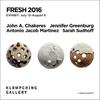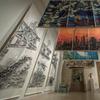New Book Highlights 13 Years of Chinese Paintings at Gianguan Auction
- NEW YORK, New York
- /
- June 04, 2015
Gianguan Auctions New York announces the publication of “Chronicle of Gianguan:Thirteen Years of Master Paintings and Calligraphy,“ a curated retrospective of important Chinese paintings that have crossed the gallery’s podium. It offers readers a visual history of Chinese ink as it evolved from the Tang Dynasty (618-907) to the contemporary.
While flying mostly under the radar of Western and Asian collectors, Gianguan Auctions, under the direction of Kwong Lum, has made a name with museum curators and Chinese collectors. Prices realized reflect the quality of works. Recently, “Ink Lotus," an ink-splash, contemporary scroll painting by H.H. Dorje Chang Buddha III, went for $16.5 million.
From studied works by the Qianlong Emperor (1711-1799) to spontaneous ink splash essays by Li Keran (1907-1989), the collection touches on the major movements in Chinese art. Each painting is allotted a full page. In some cases, details are excerpted and appear on a facing page. Such is the case of Zhang Daqian’s (1899-1983) “Yong Fei at the Hundred Flower Pavilion” that offers close ups of the facial expressions of the four players in the scene.
The volume’s text is limited to descriptions, a device that allows viewers to contemplate and make a personal interpretation of the color-corrected reproductions. This is especially appropriate for “Eagles,” a mid-century work by Pan Tianshou (1897-1971) that features two royal birds in expressive dialog.
Historic landscapes like Ju Ran’s Five Dynasties (907-960) “Landscape Scene,” a painting that compresses monumental mountains into a comprehensive visual that places man in perspective, becomes nourishment for hours of contemplation. Narrative works such Tang Yin’s (1470-1523) Ming Dynasty portrayal of “Court Ladies in Spring Festival” and the Southern Song Dynasty’s “Spring Time”, a tapestry-like depiction of a regal peacock in an equally royal setting, by Ma Lin (1180 – after 1256), are likely to spur further investigation into the unique qualities of Chinese ink paintings.
In Ding Yanyong’s (1902-1978) “Claligraphy in Couplet” one can see the modernist foundations that inform the calligraphy of contemporary Chinese artists. Two columns of imperfectly rendered characters sing their poetic message in a visual that needs no translation.
Another painting by Ding Yanyong, is a study in sharp brush strokes. Isolated aquatic animals, “Fish, Crab and Frog” are rendered as abstractionist comment on the levels of hierarchy in a socio-political food chain. Or, it could simply be accepted without narrative or associative imagination as a rendering of few interesting creatures of the deep?
Certainly it bears comparison to the individualistic work of the Qing Dynasty monk Zhu Da (also known as Bada Shanren) (1625-1705) whose works have been collected by the Metropolitan Museum of Art, the Museum of Fine Arts, Boston, and the Art of Institute of Chicago, to name a few. In “Sleeping Cat,” the artist’s ability to infuse his models with personality is clear. Although rendered in repose, one can feel the tension transmitted by alert ears and eyes that don’t fully closes. It was one of Zhu Da’s great skills to infuse personality into his subjects.
If the volume has a centerpiece it would be the triad of works of H.H. Dorje Chang Buddha III, the reigning Buddhist leader whose work has filled three museums, including the International Art Museum in Covina, California.
“Chronicle of Gianguan: Thirteen Years of Master Paintings and Calligraphy” is a 10 X 13” perfect bound volume, printed on archival quality paper. It is available for $30, direct from Gianguan Auctions New York. For details and to order, please visit www.gianguanauctions.com




10270x400_c.jpg)

















